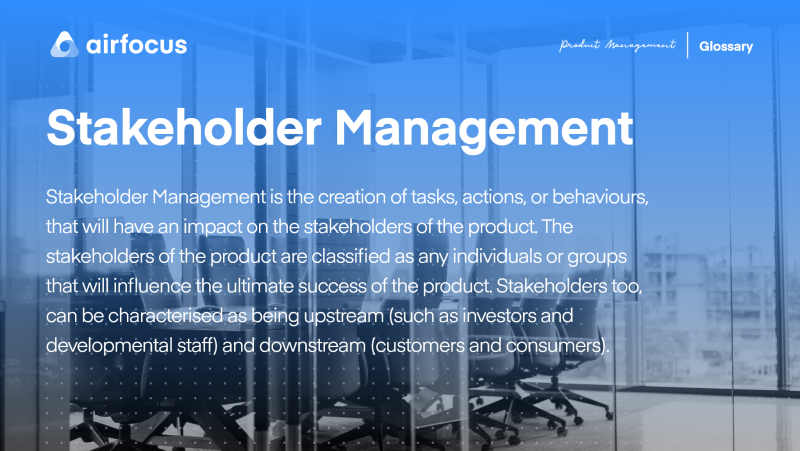Stakeholder Management
What is stakeholder management?
Definition of stakeholder management
Stakeholder management is the creation of tasks, actions, or behaviors, that will have an impact on the stakeholders of the product. The stakeholders of the product are classified as any individuals or groups that will influence the ultimate success of the product. Stakeholders too, can be characterized as being upstream (such as investors and developmental staff) and downstream (customers and consumers).
Certainly, for the product manager, the ability to manage stakeholders is a key skill since it is impossible to satisfy all requirements at all times.
Why is stakeholder management needed?
Depending on the stakeholder, the pressures placed on the product manager will differ. Stakeholders have a variety of requirements and therefore project competing interests on to product managers. Their influence can push and pull a product manager in different directions and the person in that role has to have a systematic process in place in order to successfully deal with their needs.
It is important for a product manager to keep in mind that they are not developing a product solely on the consensus of a company’s select few who may or may not buy or use the product itself. Unfortunately, this does inevitably lead to a product manager needing to be robust in the face of having to refuse requests from senior staff say, or simply having to say no. However, neither is the project manager free from the constraints of purse strings or wider business strategic objectives. All things considered, a manager has to walk a political tightrope at times and needs to be both strong and diplomatic in equal measure.
Stakeholder Management as a framework
By adhering to a framework to carry out the management of a product’s stakeholders, it is possible to be objective, fair, and also regulate the time and resources a product manager needs to give over to those people or groups. Broadly, there are four primary steps a product manager needs to take:
Stakeholder identification Identifying the product’s stakeholders is normally achieved through various research, brainstorming sessions, feedback from questionnaires, conducting interviews, the best practice established from corporate experience, and any number of other activities that provide information about who can influence the success of the product. Properly assessing one’s stakeholders is a key process as, with different needs and wants, their overall importance will be affected.
Determining the stakeholder’s impact The spheres of interest of each stakeholder have normally illustrated in a stakeholder map or something similar. This can be either a schematic or a table and can help to categorize all upstream and downstream affiliates. Typically, the types of stakeholders will fall into those people or groups carrying out the work on the product, those people or groups impacted by the product, anyone invested in the product (such as backers, shareholders, leadership, etc), and any regulating bodies.
Formulate communication strategies and plans Once the influence of any particular group or individual has been ascertained, a product manager should develop a plan for communicating with each one. A stakeholder with high interest and investment in the product will normally deserve a more detailed and intensive communication plan. Equally, a stakeholder who’s interested in the product is more optimistic may also warrant a more comprehensive strategy. Within the communication plan too, there should be decisions made regarding who should engage with each shareholder person or group. Someone other than the project manager may be more appropriate: when dealing with investors outside the immediate business for example.
Engage with stakeholders Having identified all of the product’s stakeholders, established the different ways they impact the product, and devised a plan to interact with them, a product manager can then engage the stakeholders objectively and fairly. It is crucial to note that as the development of the product ensues and the business cycle of the project revolves, the impacts a given stakeholder has on the product may change. It is necessary for the product manager to revisit the framework on a regular basis and repeat its steps to keep it up-to-date and effective.
Stakeholder analysis in stakeholder management
This is a concept that sits across the management framework. A stakeholder analysis will inform the areas of the framework dealing with stakeholder identification, stakeholder impact, and creating communication strategies. Ideally, the analysis is conducted as early as possible in the project and can be a useful tool for product managers, project managers, or program managers.
The analysis is strategic. It can be used to recruit the assistance of individuals in pivotal positions who have specialist knowledge or access to useful resources. It should also keep the strategic objectives of the business in view so that stakeholder expectations remain aligned with them. Looking forward, successful stakeholder analysis will be able to anticipate any concerns, issues, or disagreements early in the product’s development.
What to consider when assessing stakeholders
There are a number of things to consider when a product manager is attempting to assess its stakeholders. Perhaps most obvious is how the person or group will be affected by the work. There is clearly a huge difference between how a product engineer will be impacted compared to someone in marketing. From an attitude perspective, it is worth contemplating whether or not a given stakeholder will be supportive and optimistic about the project, uncertain, or even cynical.
Furthermore, something that can cause much stress for a product manager is having to handle the expectations of a person or group. They may believe their needs are more important than they really are. A manager should also give some thought to things that sway or trigger the outlook of a stakeholder: having a grasp of this can mean heading off any future issues.
And more politically, the product manager would do well to understand who is the best person to deal with a stakeholder and when. After all, stakeholders are people, meaning they will always bring politics into any business.

General FAQ

Glossary categories
All product feedback in one place

Experience the new way of doing product management








